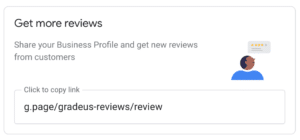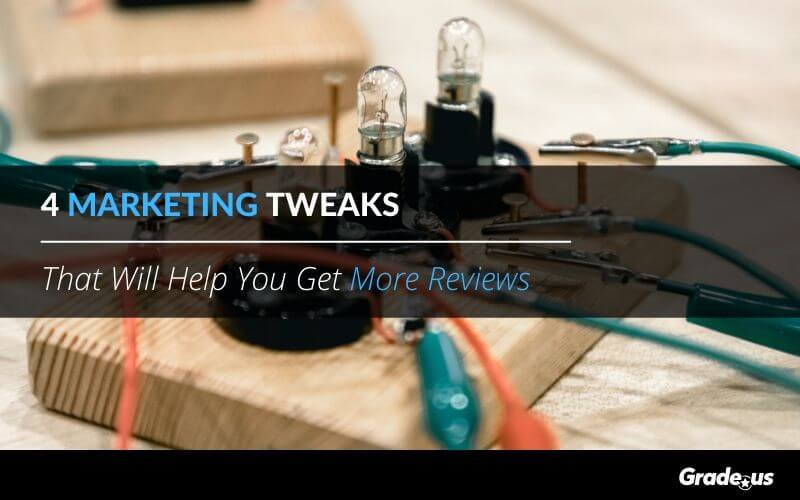In marketing, small, subtle tweaks can have a big impact. For example, a tiny change to a headline can increase conversion rates by leaps and bounds.
The same is true for gathering reviews.
The review space is competitive. There are companies with over 5,000 reviews and counting. Most businesses need every edge they can get. Especially ones that require very little time or effort to implement.
Here are four you can put into play right now.
Tweak #1: Finding the perfect time and person to ask
Asking for reviews helps no matter when you do it. Still, timing matters.
Every industry has a perfect “ask time.” You just have to find yours. There is also a perfect person in every organization to do the asking.
Here are a few industry-specific examples.
Restaurants
Who:
The waiter or waitress.
When:
At the successful conclusion of the meal, after delivering the check but before picking up payment.
Why:
People are thinking most about the restaurant and reviewing it while they’re still in the restaurant. When they leave the restaurant, other concerns start intruding pretty fast. Catching them here, with full bellies and good moods, is a smart move.
If they’re unhappy you’ll also get a chance to find out and correct the problem before your customer leaves the restaurant, which can either stop them from leaving a poor review or vastly improve the review you get.
Hotels
Who:
The clerk on-duty, or the manager.
When:
At check-out.
Why:
You want to catch the guest directly after his or her experience. Again, this lets you talk to them while their stay is right on their minds, while catching any angry guests before they storm out.
The clerk is good. The manager is better. People respond when they perceive that someone in authority is taking an interest in them and their opinions.
Car Dealerships
Who:
The salesman who worked directly with the customer.
When:
24-48 hours after purchase completion.
Why:
You don’t want to ambush customers while they’re still in the dealership, because chances are good that they’re tired of thinking about the entire process. Even in very nice dealerships the process takes hours.
48 hours later, they’ve had some fun driving around in their shiny new car, and are ready to view the whole thing in a more positive light.
Don’t wait much longer. The longer you wait, the more the customer starts to equate “shiny new car” with “massive new car payment.” The excitement fades soon after.
Lawyers
Who:
The lawyer directly responsible for handling the client’s case.
When:
7-10 days after the successful completion of the case.
Why:
Legal battles are stressful. You need to give your clients time to catch their breath.
You’re only going to directly ask the people who’ve had good outcomes for obvious reasons. It may not be your fault the case turned sour, but that doesn’t mean the client who went to jail after paying you thousands of dollars or who lost everything fighting an insurance company who won in court will have anything nice to say about you.
Medical Providers
Who:
A dedicated member of the office staff.
When:
3-5 days after the first care visit.
Why:
Nobody really expects a personalized review request from the doctor. We all kind of like the illusion that true medical professionals sort of float above all this commerce hubbub, even though that is demonstrably not the case. The cheerful person who checked them in and chatted with them in the waiting room is a perfect choice.
You don’t want to keep sending out review requests after additional visits; it looks unseemly. You also don’t want to wait for the medical bills to come in. If the patient liked the doctor’s office, he or she will be happy to review it even though their problem may not be fixed yet.
In some of these examples, the proper person is asking in person. In others, they’ll be using email or SMS. In all of them, asking needs to be made into a routine, just as much a part of the customer experience as ringing them up or doing the job for them.
Tweak #2: Claiming your Google My Business short name
A solid review strategies puts requests in a lot of places.
It relies on a mixture of verbal requests, requests delivered via physical marketing materials, email review requests, and SMS review request messages to work. Any time you’re not putting a link directly in front of them you are relying on your customers to take a whole bunch of steps.
Remember to leave a review. Choose a review platform. Go find your site on the review platform. Log in to said platform. Leave said review.
That’s too many steps. The modern brain is too overloaded.
Enter GMB short names.
With GMB short names, you get a URL that looks like this:
g.page/bizname
GMB also makes it easy for your to leave a review by appending review to the short name link:

It’s easy to say. It’s easy to type. It gets customers directly to a spot where they can leave you a review.
Tweak #3: Asking, "Do you have Google maps on your phone?"
Most review sites require you to have an account before they’ll let you leave a review. It’s their (bare minimum) defense against review fraud.
GMB no longer does. Not if you have the Google Maps app on your phone, anyway.
Asking this question lets you educate customers as to how they can help you out without making an account they might not want. It’s as easy as:
- Tapping on the app.
- Searching for the business.
- Scrolling down to the 5 greyed out stars in the review section.
- Tapping on them to leave a review.
This is an especially effective tactic with older customers. Members of the Greatest Generation in particular really hate giving online sites any information about themselves. Many Boomers aren’t too thrilled about it either.
Offering this alternative helps you get feedback from an entirely different demographic. If you want to do an even better job of tapping into this demographic, you’ll send out requests by mail, with the instructions printed on the postcard so the older person can do it in the privacy of their own home as slowly as they need to in order to get the job done. Doing it this way means you don’t have to force them to remember all the instructions once they get home.
That’s not a dig on older folks. My Gen Z kid can’t remember a whole lot of things said to him five minutes ago. For that matter, neither can my Gen X brain. It’s more a commentary on the preferences of the people involved. Both me and my kid have Google accounts and have left tons of reviews for people, after all.
Tweak #4: Personalized responses
Responding to every single review, regardless of whether it’s positive or negative, can increase the number of reviews you receive by up to 12%. Personalizing those responses makes them even more powerful.
Most people know you can do this on the review platform itself. That’s basic.
This technique is even more powerful if you also stop to thank the reviewer in person the next time he or she comes by your establishment, or send a quick personal email to let them know you saw their review and appreciated it.
It’s not that this will generate a new review. Instead, it will generate warm feelings which might result in some word-of-mouth advertisement. More than that, it could result in a customer that sticks with you for life, which is arguably even more valuable.
What are your review tweaks and hacks?
Have you come up with some specific tweaks and hacks that help you get more or better reviews? Let us know in the comments below, or give us a shout-out on twitter at @GradeUs!
We’re always on the lookout for new, actionable tips we can use to help businesses maximize their review profiles.









